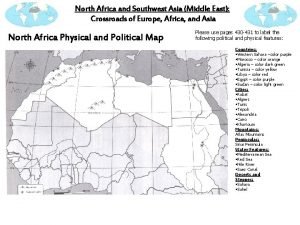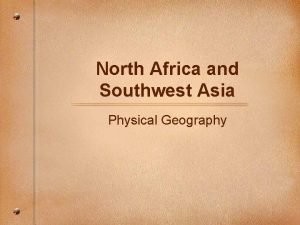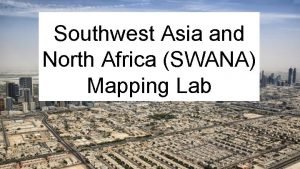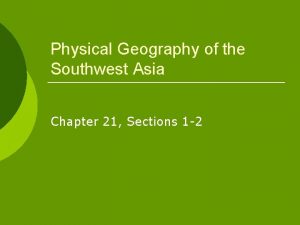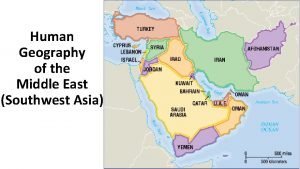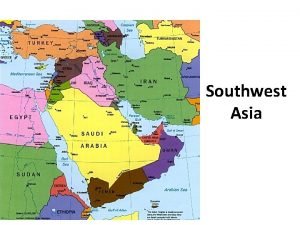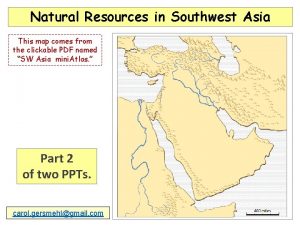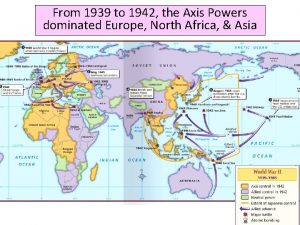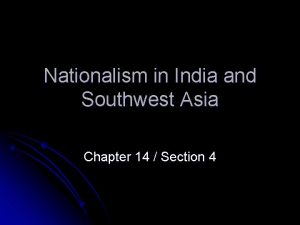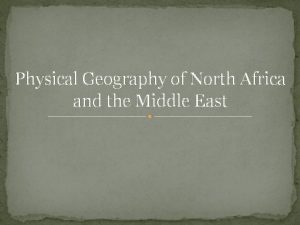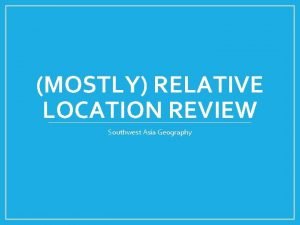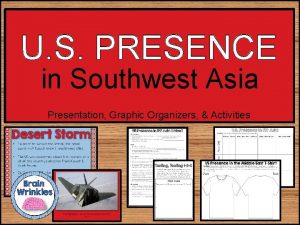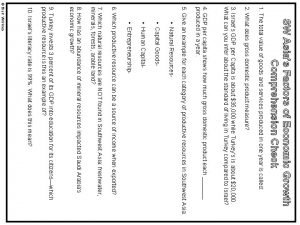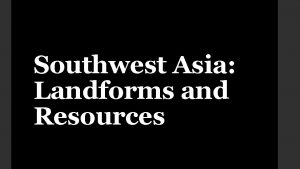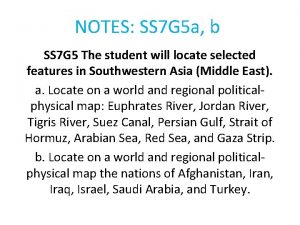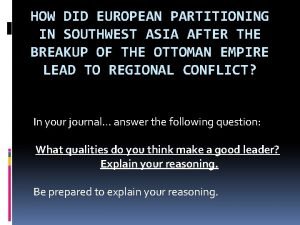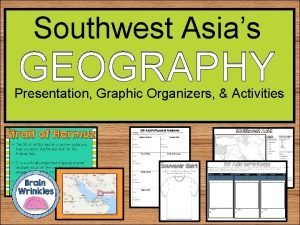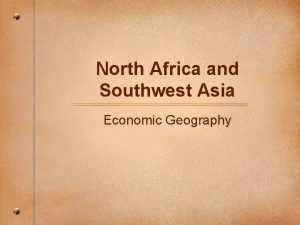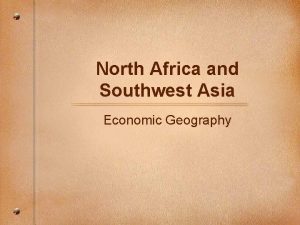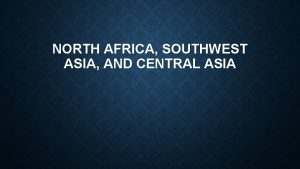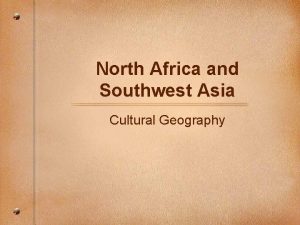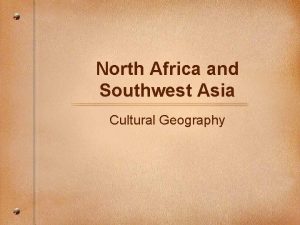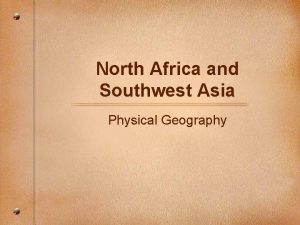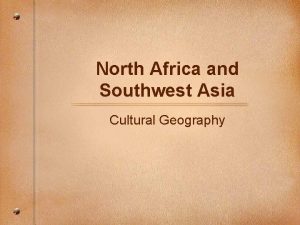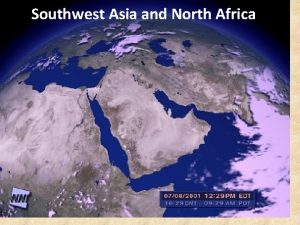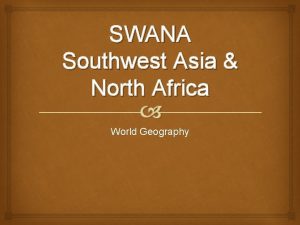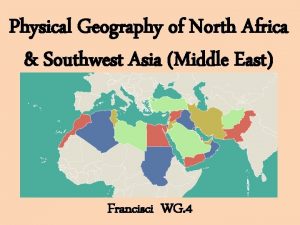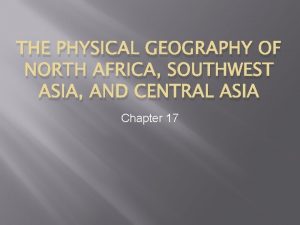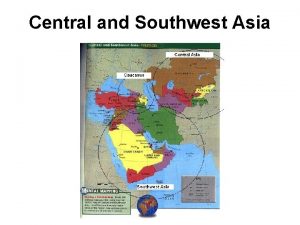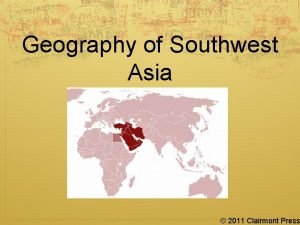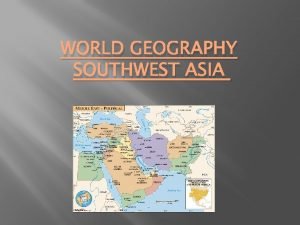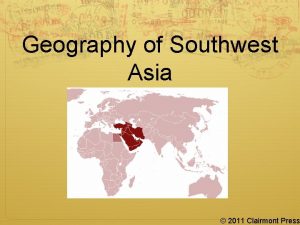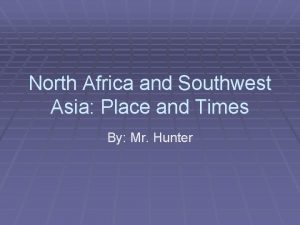North Africa and Southwest Asia Economic Geography Natural































- Slides: 31

North Africa and Southwest Asia Economic Geography

Natural Resources • Oil is the major resource in this region. • Many countries in this region are members of OPEC (Organization of Petroleum Exporting Countries). • OPEC sets the price and production of oil and has members all over the world.

Countries With Oil Countries with oil Saudi Arabia Iraq Iran UAE Kuwait Qatar Libya Countries that have very little oil Israel Turkey Jordan Lebanon Syria Morocco Afghanistan

Natural Resources • There are positive and negative effects from oil revenues. Some countries have used oil money to build infrastructure such as schools, telecommunication systems, and hotels to attract tourists. However, oil fluctuates on the world market so it makes it difficult to plan for the future.

Positive and Negative Positive/Oil Negative/Oil 1. Oil is valuable 2. Oil money is used to build infrastructure 3. People have a high GDP per capita 1. Oil fluctuates on the world market 2. Oil will run out eventually





Natural Resources • The most important resource in this region is fresh water. These countries need water to irrigate crops. Some countries have major rivers such as Turkey, Iraq, Israel, Syria, and Egypt. • Other countries get fresh water by converting salt water from the ocean into fresh water in a process called desalinization. This process is expensive and requires capital investment.

Natural Resources • Other resources that are found in this area are: phosphates, copper, coal, citrus products, and cotton.

Economic Activity • Primary - Resources are gathered (farming, hunting, fishing, timber falling, mining) • Secondary - Resources are processed or manufactured into goods. • Tertiary - The service industry (distributing, advertising, transportation, government employees, banking, retail sales)

Economic Activity • This region is highly dependant on primary economic activity. A. Oil drilling B. Agriculture (People grow foods in irrigated areas along rivers and on the Mediterranean Coast) C. Pastoralism (Nomadic Herding - People raise herds of goats, sheep, and cattle)

Guest Workers • Countries with oil have small populations. The labor shortage is filled by guest workers from south and east Asian countries such as India, Philippines, Pakistan, and Indonesia.

Agriculture • Agriculture in this region is limited to areas near rivers or areas that can be irrigated. Areas with significant agriculture are: A. Near the Nile River in Egypt B. Near the Tigris and Euphrates Rivers in Turkey and Iraq C. Heavily irrigated areas in Israel near the Jordan River


Kibbutz in Israel

Aswan High Dam • The Aswan High Dam on the Nile River was completed in 1970. The dam was built to: A. Stop seasonal flooding on the Nile River. B. Provide hydroelectric power for Egypt. C. Provide a steady source of water for irrigation.


Trade Important to Region • Trade has always been important to this region because it is halfway between Europe and Asia. A. The Silk Road linked China to Europe B. Trade routes crossed the Sahara Desert and linked Sub-Saharan Africa to Europe


Contemporary Trade Routes • This area has many important trade routes or sealanes such as: A. The Bosporus and Dardanelles connect the Black Sea and the Mediterranean Sea B. The Suez Canal connects the Mediterranean Sea to the Red Sea C. The Strait of Hormuz connects the Persian Gulf to the Arabian Sea and Indian Ocean





Suez Canal • The Suez Canal connects the Mediterranean Sea to the Red Sea. • The Suez Canal is owned by the Suez Canal Authority, a state owned company. • The average toll for a ship passing through the canal is 150, 000 dollars.

Tourism • Some countries in this region make money from tourism. A. People visit Egypt to see the pyramids B. People visit Jerusalem to see holy sites (Dome of the Rock, Western Wall, Church of the Holy Sepulchre) C. People visit Mecca (The Hajj)

Developed or Developing? • This region has a wide range of per capita income and levels of development. High GDP Per Capita Israel - 26, 600 Saudi Arabia - 19, 800 UAE - 37, 000 Qatar - 87, 000 Kuwait - 55, 900 Low GDP Per Capita Iraq - 3, 700 Iran - 11, 700 Lebanon - 10, 300 Syria - 4, 700

Developed or Developing? • Countries are rated by economic indicators and standards of living. This area has some countries with relatively high standards of living and other countries that are very poor. Analyze the countries on the next slide based on standards of living.

Standards of Living Country A Country B Pop. Growth Rate 3. 83% 2. 18% GDP per capita 37, 000 77. 9% 75. 89 13. 11 4, 700 79. 6% 70. 9 26. 78 Literacy Rate Life Expectancy Infant Mortality
 North africa and southwest asia physical geography
North africa and southwest asia physical geography Southwest asia and north africa map
Southwest asia and north africa map Political map of southwest asia and north africa
Political map of southwest asia and north africa North africa southwest asia physical map
North africa southwest asia physical map North africa and southwest asia mountains
North africa and southwest asia mountains Southwest and central asia mapping lab answer key
Southwest and central asia mapping lab answer key Chapter 22 human geography of southwest asia
Chapter 22 human geography of southwest asia Map of southwest asia
Map of southwest asia Human geography of middle east
Human geography of middle east Chapter 21 physical geography of southwest asia
Chapter 21 physical geography of southwest asia Natural resources of southwest asia
Natural resources of southwest asia Who dominated europe, north africa and asia from 1939-1942?
Who dominated europe, north africa and asia from 1939-1942? America asia africa
America asia africa Nationalism in india and southwest asia
Nationalism in india and southwest asia Judaism vs islam chart
Judaism vs islam chart Nationalism in india and southwest asia
Nationalism in india and southwest asia Nationalism in india and southwest asia
Nationalism in india and southwest asia Physical features of the middle east map
Physical features of the middle east map Chapter 15 lesson 1 physical geography of north africa
Chapter 15 lesson 1 physical geography of north africa Environmental issues graphic organizer
Environmental issues graphic organizer Landforms of the southwest
Landforms of the southwest Which southwest asian country is the farthest east
Which southwest asian country is the farthest east Fertile crescent
Fertile crescent Brain wrinkles southwest asia answer key
Brain wrinkles southwest asia answer key Voluntary trade comprehension check
Voluntary trade comprehension check Sw asian economies comprehension check
Sw asian economies comprehension check Kurdish coat of arms
Kurdish coat of arms Southwest asia landforms
Southwest asia landforms Tigris river map
Tigris river map Nationalism in southwest asia
Nationalism in southwest asia Europe partitioning in southwest asia answer key
Europe partitioning in southwest asia answer key South west asia
South west asia


